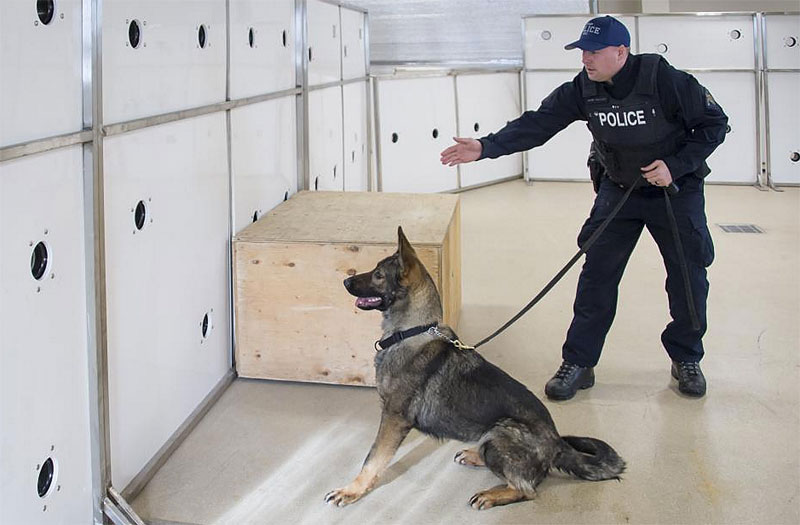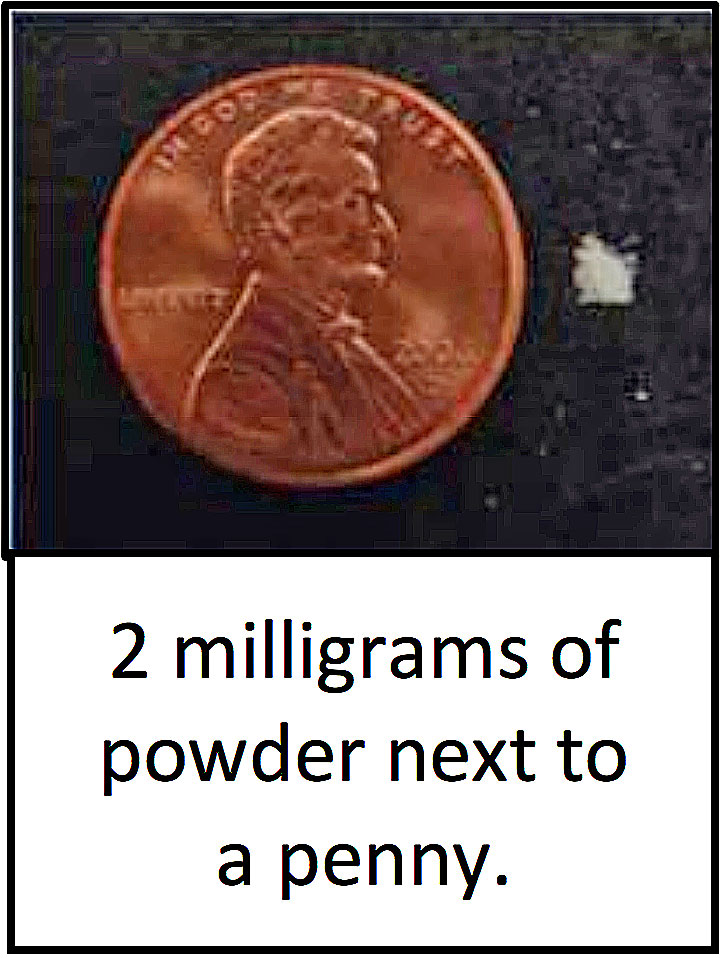
The Royal Canadian Mounted Police’s Police Dog Service Training Centre (PDSTC) was honored at the 2017 ‘ASTORS’ Homeland Security Awards ceremony in New York for its innovation in the fight against illicit fentanyl.
 Recognized for developing a technique that safely trains dogs to detect the powerful opioid, the PDSTC earned a Platinum ‘Excellence in Homeland Security’ Award.
Recognized for developing a technique that safely trains dogs to detect the powerful opioid, the PDSTC earned a Platinum ‘Excellence in Homeland Security’ Award.
The ceremony was organized by American Security Today, a digital publication that profiled the technique after the RCMP announced it would train all of its 139 narcotics-profile dogs across Canada.
The efforts of our neighbors to the North can only benefit the US and strengthen our combined efforts along our northern border.
And their training is paying off.
(Akrum Ghadban, Officer in Charge, Royal Canadian Mounted Police Dog Service Training Centre (at right) – being interviewed by Dr. Kathleen Kiernan, Founder and Chief Executive Officer, Kiernan Group Holdings, on behalf of AST. Courtesy of American Security Today and YouTube)
“I do believe the Canadian population is safer because of our new fentanyl dog training.”
“By keeping more fentanyl off the street, we save Canadian lives,” says Inspector Akrum Ghadban, Officer in Charge of the RCMP Police Dog Service Training Centre (PDSTC) in Innisfail, Alberta.
The RCMP leads the way in dog training to detect fentanyl.

(Image courtesy of the RCMP)
“Our specialists have transformed pure fentanyl into a diluted liquid form, enabling our dogs to train with the real smell of fentanyl with no risk of inhaling it.
It is particularly efficient, making the dogs in the field extremely productive,” explained Staff Sergeant Eric Stebenne, Senior Trainer at the RCMP PDSTC.
RCMP specialists transform pure fentanyl into a diluted liquid form, which allows the dogs to train with the scent of real fentanyl without risk of inhaling it, rendering the technique safe and efficient and making the dogs extremely productive in the field.
During police operations, the dogs can detect fentanyl from a safe distance and dog handlers are trained to administer an antidote to canines who may inadvertently come into contact with the drug.
(See the process of diluting fentanyl into liquid form to be used safely, for RCMP Police Service Dog training to detect fentanyl. Courtesy of RCMP and YouTube)
“Illegal opioids are a major concern around the world as a public safety issue,” added Inspector Ghadban.
“Last year, in Canada alone, law enforcement seized about 18 kilograms of fentanyl, which is significant considering just a few grains can cause an overdose.”

participants from police forces across the continent eager to see
the centre’s pioneering work in tackling the scourge of fentanyl. (Image
courtesy of the RCMP)
“I’m very proud of our work as a team in developing this training program and sharing it with other law enforcement partners.”
“It is an honor to accept this award on behalf of the Royal Canadian Mounted Police.”
In February, the RCMP held a two-day workshop on canine fentanyl detection, hosting 35 participants from across North America at the PDSTC, located in Innisfail, Alberta.
Fentanyl is an opioid approximately 100 times more potent than morphine which can cause serious harm, including death, when used improperly. It has been distributed illegally in many forms, including in tablets made to look like prescription drugs.
Risks to Law Enforcement
In addition to being deadly to users, fentanyl poses a grave threat to law enforcement officials and first responders, as a lethal dose of fentanyl can be accidentally inhaled or absorbed through the skin.
The DEA released the following Police Roll Call video nationwide to warn law enforcement about this danger.
(‘FENTANYL – A Real Threat to Law Enforcement,’ courtesy of the DEA, the Department of Justice, and YouTube)
The onset of adverse health effects, such as disorientation, coughing, sedation, respiratory distress or cardiac arrest is very rapid and profound, usually occurring within minutes of exposure.
If inhaled, move to fresh air, if ingested, wash out mouth with water provided the person is conscious and seek immediate medical attention.
Narcan (Naloxone), the overdose-reversing drug, is an antidote for opiate overdose and may be administered intravenously, intramuscularly, or subcutaneously.
Immediately administering Narcan can reverse an accidental overdose of fentanyl exposure to officers.
Continue to administer multiple doses of Narcan until the exposed person or overdose victim responds favorably.
Canine units are particularly at risk of immediate death from inhaling fentanyl.
(In Florida a police dog named Primus accidentally overdosed after coming in contact with the drug Fentanyl during an October police raid, which has led to changes in the way Police approach narcotics investigations. Courtesy of Wochit News and YouTube)
Field Testing / Safety Precautions
Law enforcement officers should be aware that fentanyl and its compounds resemble powered cocaine or heroin, however, should not be treated as such.
If at all possible do not take samples if fentanyl is suspected. Taking samples or opening a package could stir up the powder.

availability, seizures, and known overdose deaths than at
any other time since the drug’s creation in 1959.
If you must take a sample, use gloves (no bare skin contact) and a dust mask or air purifying respirator (APR) if handling a sample, or a self-contained breathing apparatus (SCBA) for a suspected lab.
If you have reason to believe an exhibit contains fentanyl, it is prudent to not field test it.
Submit the material directly to the laboratory for analysis and clearly indicate on the submission paperwork that the item is suspected of containing fentanyl.
This will alert laboratory personnel to take the necessary safety precautions during the handling, processing, analysis, and storage of the evidence.
Officers should be aware that while unadulterated fentanyl may resemble cocaine or heroin powder, it can be mixed with other substances which can alter its appearance.

potential dangers to first responders. For instance with suspected narcotics,
which could potentially be life-threatening fentanyl or fentanyl-class substances.
As such, officers should be aware that fentanyl may be smuggled, transported, and/or used as part of a mixture.
Universal precautions must be applied when conducting field testing on drugs that are not suspected of containing fentanyl.
Despite color and appearance, you can never be certain what you are testing.
In general, field testing of drugs should be conducted as appropriate, in a well ventilated area according to commercial test kit instructions and training received.
Sampling of evidence should be performed very carefully to avoid spillage and release of powder into the air.
At a minimum, gloves should be worn and the use of masks is recommended. After conducting the test, hands should be washed with copious amounts of soap and water.
Never attempt to identify a substance by taste or odor.
Carfentanil: A Dangerous New Factor in the U.S. Opioid Crisis (DEA Officer Safety Alert)
Carfentanil is a synthetic opioid approximately 10,000 times more potent than morphine and 100 times more potent than fentanyl.

The presence of carfentanil in illicit U.S. drug markets is cause for concern, as the relative strength of this drug could lead to an increase in overdoses and overdose-related deaths, even among opioid-tolerant users.
Carfentanil is used as a tranquilizing agent for elephants and other large mammals.
The lethal dose range for carfentanil in humans is unknown; however, carfentanil is approximately 100 times more potent than fentanyl, which can be lethal at the 2- milligram range, depending on route of administration and other factors.
For additional information, click here to visit the DEA website and here to visit the RCMP and please – be safe out there.

















